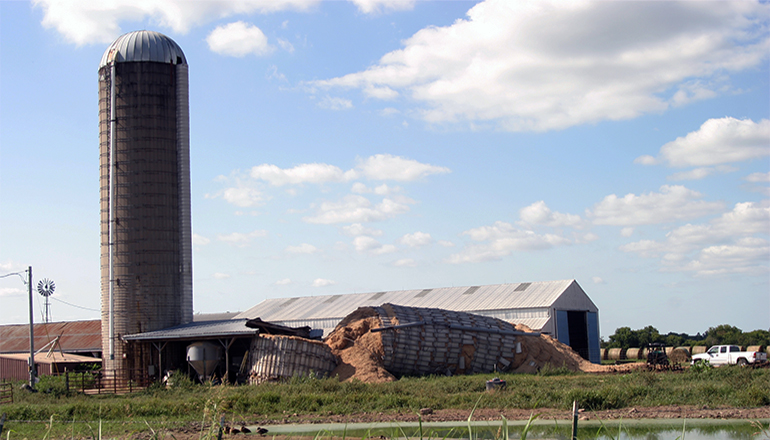Many dairy producers are starting the silage season with empty silos this summer, says Reagan Bluel, dairy specialist for University of Missouri Extension. That presents a good opportunity to inspect those silos for problems.
Producers turned to silage stockpiles this winter to feed cattle after the drought of 2018. Tower silos, designed to store chopped fermented silage, are at risk due to age and use. Concrete and steel corrosion compromises the structural integrity of the silo. “As a result, tower silos in disrepair may collapse because they can no longer carry the design loads caused by the stored forage,” says MU Extension agricultural engineer Joe Zulovich.
Empty silos are easier to inspect for structural damage than those being topped off, says Bluel. “Now is the time to make a visual check the entire exterior for cracks and settlement,” she says. “Additionally, check interior sidewalls for cracks and degradation. If you can see daylight through a tower silo wall, you have a tower silo that is likely structurally compromised.”
Check the silo discharge door, roof and wall openings for sagging, she adds. Roofs can receive damage from overfilling, vibrations and the environment. Check regularly. Climb into the silo and inspect sidewalls for cracks and bulges. Wear a mask to prevent breathing issues in the confined space. Immediately make a plan if you find faults. Consider treating surface problems to prevent collapse, or using alternative storage for the 2019 silage crop. Perform regular preventive maintenance.
During her work with dairy farmers in southwestern Missouri, Bluel finds that leaning silos usually collapse within 24 hours. This puts lives and crops at risk. Proactive inspections reduce the likelihood of injury and costly cleanup. Zulovich notes that many silo failures are not included on insurance policies.
Be sure to harvest corn silage at the correct moisture, Bluel says. “If harvesting forage when it is juicier than ideal, as the feed ferments, the excess leachate containing acid from the silage will eat away at the concrete walls and foundation and weaken silo structure.”
Bluel says it is important to train new workers on the correct way to blow silage or green fodder into the silo.
Teach workers to blow silage using a silo forage distributer to evenly spread forage or blow forage exactly into the center of the silo to evenly load silo walls. Uneven loads on a tower silo wall will likely cause the silo to collapse. Teach workers how to properly unload the forage wagon and monitor the silo blower. Use fall protection and work with a partner, particularly during harvest season, Bluel says.
Bluel recommends “Deterioration of Concrete Tower Silos,” a fact sheet from the Ontario Ministry of Agriculture, Food and Rural Affairs, available for download at THIS LINK.
According to the International Silo Association, stone structures for grain storage date back more than 3,000 years. Until the 1800s, silage was typically stored in pits. An Illinois farmer named Fred Hatch is often credited with building the first modern silo in the U.S. in 1873. He dug an 8-foot pit in his barn and built a 16-foot aboveground extension made of wood. In an 1891 bulletin from the University of Wisconsin (updated in 1919 by the University of Missouri), agricultural scientist F.H. King promoted an improved type of silo that drew on the lessons of his detailed study of silo designs in the Midwest.
The King Silo, as it came to be known, featured a now-familiar cylindrical design that reduced spoilage by eliminating corner air pockets and allowing tighter packing of silage. The following years saw extensive silage education through farm magazines, agricultural college bulletins and field demonstrations. Dairy and beef regions adopted the technology. Beef operations needed more storage capacity, and concrete block/stave and poured concrete silos appeared. While silos are not the only method for storing silage, this old science is still highly effective in storing high-quality feed for your dairy, says Bluel.







